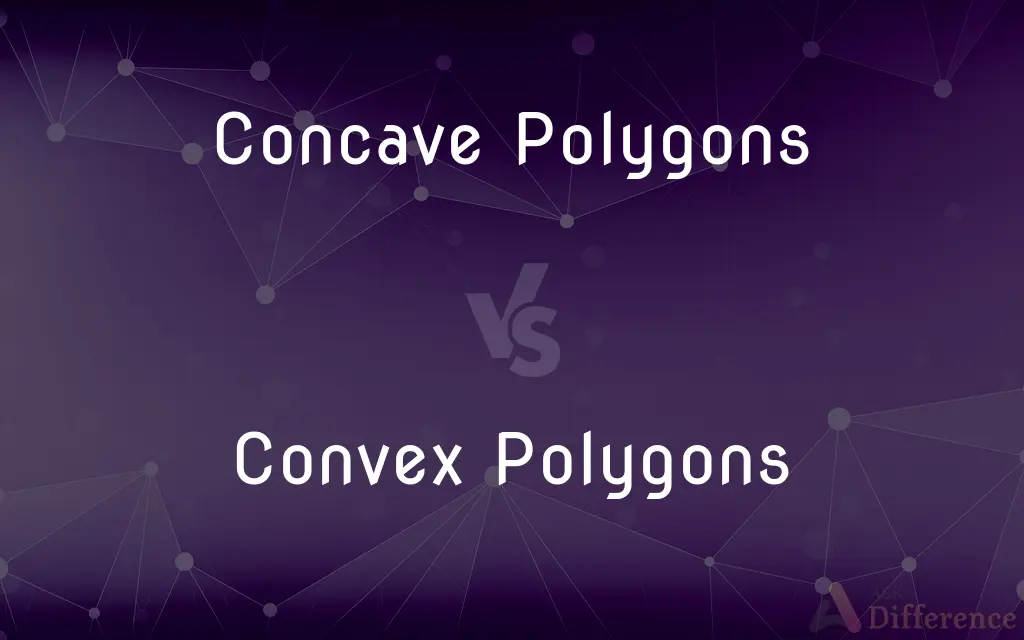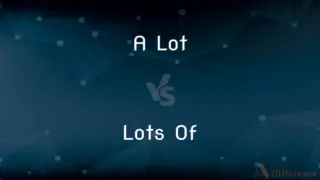Concave Polygons vs. Convex Polygons — What's the Difference?
Edited by Tayyaba Rehman — By Fiza Rafique — Published on November 22, 2023
Concave Polygons have at least one angle > 180°, while Convex Polygons have all angles < 180°.

Difference Between Concave Polygons and Convex Polygons
Table of Contents
ADVERTISEMENT
Key Differences
Concave Polygons present a unique geometric structure, offering an inward curve, or caving at least at one point on their perimeters. Convex Polygons, contrastingly, possess a structure where all its points on the perimeter point outward or bulge away. Both possess entirely different properties when it comes to angles, vertices, and real-world applications, emphasizing their uniqueness and importance in geometry.
In practical applications, Concave Polygons may not always fit well within certain mathematical models, such as computational geometry algorithms. Convex Polygons are often favored in these contexts due to their simpler, outward-bulging nature which ensures that any line segment drawn between any two points inside the polygon will always remain inside the polygon. This leads to the fact that mathematical and computer algorithms often find it easier to work with convex shapes.
When discussing interior angles, Concave Polygons display a variance as they possess at least one interior angle measuring more than 180 degrees. In contrast, Convex Polygons consistently showcase interior angles that are less than 180 degrees, establishing a straightforward, outward-projecting shape without any recesses, which can be easier to analyze in certain mathematical scenarios.
In computational applications, the distinction between Concave and Convex Polygons can be vital. Algorithms for processes like collision detection in video games often prefer Convex Polygons because of their straightforwardness in mathematical calculations. Whereas, dealing with Concave Polygons may require additional computational resources due to their inward-curving nature.
Navigating through real-world applications, Concave Polygons might be observed in designs or structures that require an indentation or an inward design aspect for aesthetic or functional purposes. Conversely, Convex Polygons might be observed in scenarios that necessitate a bulging outward feature, such as in certain architectural designs or objects, owing to their all-outward-pointing vertices.
ADVERTISEMENT
Comparison Chart
Definition
Have at least one angle > 180°.
All angles are < 180°.
Interior Angles
Contains at least one angle > 180°.
All angles are < 180°.
Example Shape
A polygon that looks like it has a bite taken out of it.
A regular, outward-bulging polygon.
Real-world Applications
Used where an inward curve is needed in design.
Preferable where robustness is desired.
Computational Simplicity
Can be computationally complex to manage.
Typically simpler to calculate and manage.
Compare with Definitions
Concave Polygons
Concave Polygons possess at least one diagonal that exists outside of the polygon.
In Concave Polygons, certain diagonals, when drawn, stretch outside the figure.
Convex Polygons
Convex Polygons have all interior angles less than 180 degrees.
Squares are Convex Polygons that are utilized in numerous grid designs.
Concave Polygons
Concave Polygons can have a portion of their perimeter curved inward.
Concave Polygons are evident in various artistic designs that require an inward curve.
Convex Polygons
Convex Polygons are computationally simpler to manage in many algorithms.
In collision detection, Convex Polygons are often preferred for simplicity.
Concave Polygons
Concave Polygons are not always the preferable choice in computational geometry.
For algorithmic simplicity, programmers sometimes avoid using Concave Polygons.
Convex Polygons
Convex Polygons ensure that any line segment between two points within them lies inside the polygon.
Convex Polygons are advantageous in 3D modeling due to their inherent simplicity.
Concave Polygons
Concave Polygons contain at least one vertex that is not part of the polygon’s hull.
The arrow shape is a classic example of Concave Polygons with an inward-pointing vertex.
Convex Polygons
Convex Polygons do not possess any vertex that’s pushed inward.
A regular hexagon, used often in board game designs, is a Convex Polygon.
Concave Polygons
Concave Polygons have at least one interior angle greater than 180 degrees.
The logo of a star often uses Concave Polygons in its design.
Convex Polygons
Convex Polygons ensure all diagonals are contained within the polygon.
Convex Polygons, like rectangles, ensure all diagonals remain inside.
Common Curiosities
Are all angles in Convex Polygons less than 180 degrees?
Yes, all angles in Convex Polygons are less than 180 degrees.
Can Concave Polygons have all angles less than 180 degrees?
No, Concave Polygons must have at least one angle greater than 180 degrees.
Is it true that Convex Polygons have no vertices pushed inward?
Yes, Convex Polygons have all vertices bulging outward.
What is one primary visual difference between Concave and Convex Polygons?
Concave Polygons have at least one inward-pushing vertex, whereas Convex Polygons do not.
Are Convex Polygons computationally simpler to manage?
Yes, due to their straightforward geometric nature, Convex Polygons are often simpler computationally.
Why are Convex Polygons preferred in certain algorithms?
Convex Polygons are preferred for their geometric simplicity and all-internal diagonals.
What defines Concave Polygons?
Concave Polygons have at least one angle measuring more than 180 degrees.
Is it true that Concave Polygons might contain a diagonal outside the polygon?
Yes, Concave Polygons can have at least one diagonal lying outside the polygon.
Are star-shaped polygons considered Concave Polygons?
Yes, because star-shaped polygons have inward-pushing vertices, making them Concave Polygons.
Is it difficult to calculate the area of Concave Polygons?
It can be more complex due to the inward vertices which may require additional calculations.
Can a Concave Polygon be converted to a Convex Polygon?
Not without altering its vertices and hence changing its original shape.
Can Convex Polygons have an interior angle greater than 180 degrees?
No, all interior angles in Convex Polygons are less than 180 degrees.
Are squares considered Convex Polygons?
Yes, squares, having all angles less than 180 degrees, are Convex Polygons.
Share Your Discovery

Previous Comparison
Accidental Degeneracy vs. Normal Degeneracy
Next Comparison
A Lot vs. Lots OfAuthor Spotlight
Written by
Fiza RafiqueFiza Rafique is a skilled content writer at AskDifference.com, where she meticulously refines and enhances written pieces. Drawing from her vast editorial expertise, Fiza ensures clarity, accuracy, and precision in every article. Passionate about language, she continually seeks to elevate the quality of content for readers worldwide.
Edited by
Tayyaba RehmanTayyaba Rehman is a distinguished writer, currently serving as a primary contributor to askdifference.com. As a researcher in semantics and etymology, Tayyaba's passion for the complexity of languages and their distinctions has found a perfect home on the platform. Tayyaba delves into the intricacies of language, distinguishing between commonly confused words and phrases, thereby providing clarity for readers worldwide.













































